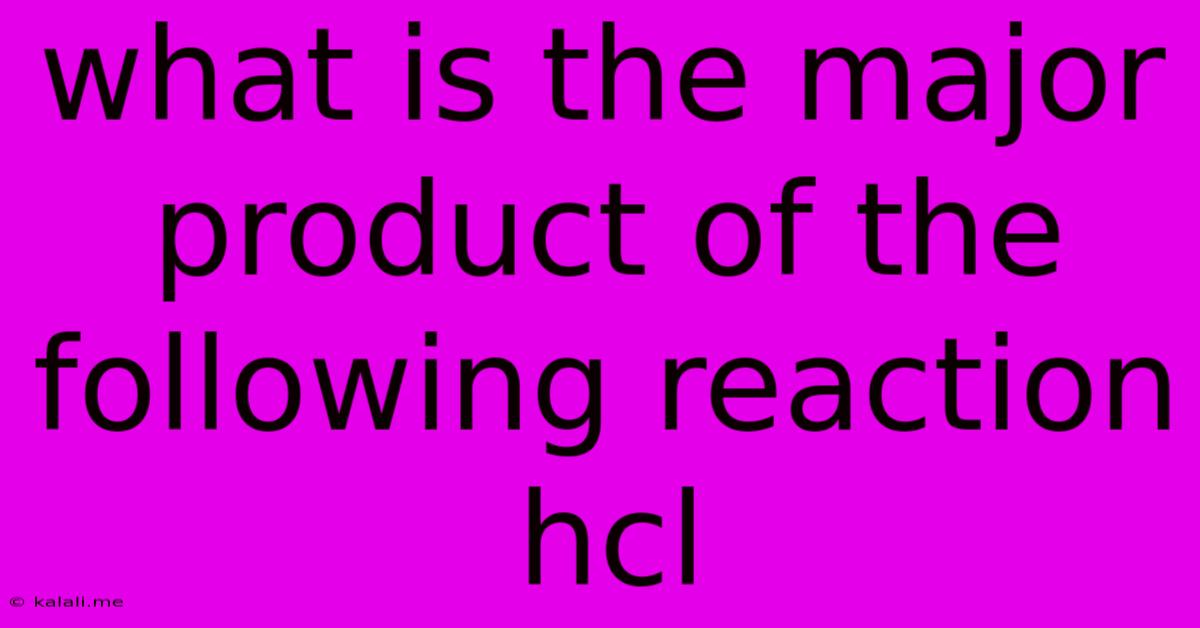What Is The Major Product Of The Following Reaction Hcl
Kalali
Jun 15, 2025 · 3 min read

Table of Contents
What is the Major Product of the Following Reaction: HCl?
This question is intentionally broad, as the major product of a reaction involving hydrochloric acid (HCl) depends entirely on the reactant it's combined with. HCl, a strong acid, participates in a wide variety of reactions. To accurately predict the major product, we need to know the specific substance reacting with HCl. This article will explore several common reactions involving HCl and the resulting major products. Understanding reaction mechanisms and predicting products is crucial in chemistry. This explanation will delve into the possibilities.
Understanding HCl Reactivity:
Hydrochloric acid acts as a strong Brønsted-Lowry acid, readily donating a proton (H⁺). This makes it highly reactive with various compounds, including:
-
Metals: HCl reacts with many reactive metals (like zinc, magnesium, iron) to produce a metal chloride salt and hydrogen gas. For example, the reaction between zinc and HCl yields zinc chloride and hydrogen:
Zn(s) + 2HCl(aq) → ZnCl₂(aq) + H₂(g)In this case, zinc chloride (ZnCl₂) and hydrogen gas (H₂) are the major products.
-
Metal Oxides: Reaction with metal oxides produces the corresponding metal chloride and water. For instance, reacting HCl with copper(II) oxide produces copper(II) chloride and water:
CuO(s) + 2HCl(aq) → CuCl₂(aq) + H₂O(l)Here, the major products are copper(II) chloride (CuCl₂) and water (H₂O).
-
Metal Carbonates and Bicarbonates: HCl reacts with metal carbonates and bicarbonates to produce a metal chloride, carbon dioxide, and water. For example, with calcium carbonate:
CaCO₃(s) + 2HCl(aq) → CaCl₂(aq) + CO₂(g) + H₂O(l)The major products are calcium chloride (CaCl₂), carbon dioxide (CO₂), and water (H₂O).
-
Bases: Neutralization reactions occur when HCl reacts with bases (like sodium hydroxide). This produces a salt and water.
NaOH(aq) + HCl(aq) → NaCl(aq) + H₂O(l)The major products are sodium chloride (NaCl) and water (H₂O).
-
Organic Compounds: HCl can participate in various reactions with organic compounds, often acting as a catalyst or participating in substitution or addition reactions. The specific product will drastically vary depending on the organic molecule involved. These reactions are often complex and require specific conditions.
Predicting the Major Product:
To determine the major product of a reaction involving HCl, you must:
- Identify the reactant: Knowing the other chemical involved is crucial.
- Consider the type of reaction: Is it a single displacement, double displacement, acid-base neutralization, or something more complex?
- Balance the chemical equation: Ensure the number of atoms of each element is equal on both sides of the equation.
- Determine the products: Based on the reaction type and the reactants involved, predict the products formed.
In Conclusion:
Without specifying the reactant interacting with HCl, it's impossible to definitively state the major product. However, this article provides examples of several common reactions and their corresponding major products, illustrating the diverse reactivity of hydrochloric acid. Always consider the specific reactants and reaction conditions to accurately predict the outcome. Remember to always handle HCl with appropriate safety precautions in a laboratory setting.
Latest Posts
Latest Posts
-
If Abc Is An Equilateral Triangle
Jun 16, 2025
-
What Is A Factor Of 44
Jun 16, 2025
-
Which Of The Following Is Not A Strong Base
Jun 16, 2025
-
The Atomic Number Is Determined By The Number Of
Jun 16, 2025
-
Normal Profit Is Also Known As Economic Profit
Jun 16, 2025
Related Post
Thank you for visiting our website which covers about What Is The Major Product Of The Following Reaction Hcl . We hope the information provided has been useful to you. Feel free to contact us if you have any questions or need further assistance. See you next time and don't miss to bookmark.